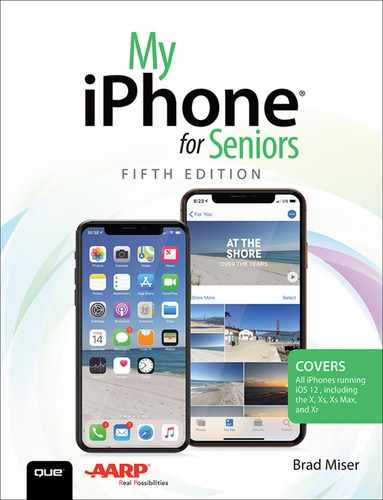15
Working with Other Useful iPhone Apps and Features
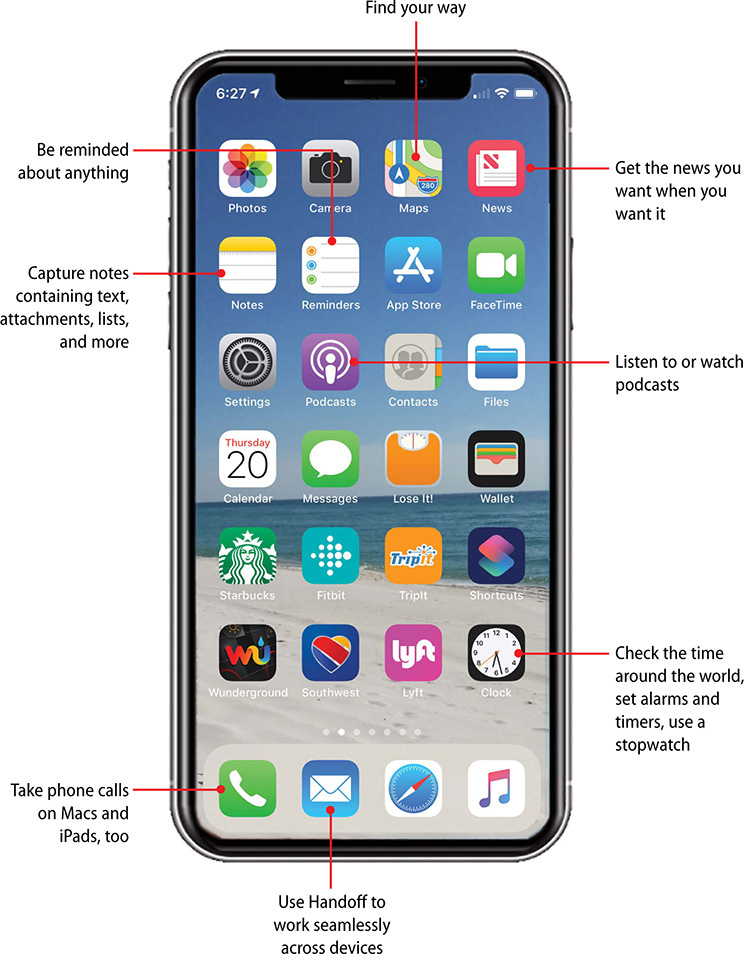
In this chapter, you learn about some other really useful apps and iPhone functionality. Topics include the following:
→ Touring other cool iPhone apps
→ Listening to music with the Music app
→ Managing your health information with the Health app
→ Using Bluetooth to connect to other devices
→ Connecting your iPhone to other iPhones, iPod touches, or iPads
→ Working with the Wallet app and Apple Pay
→ Working seamlessly across your devices
An iPhone can truly become your iPhone over time as you use the apps and features that you find to be useful for living your daily life, traveling, communicating, and so on. The great thing about iPhone apps is that there are so many to choose from, and because many of them are free, you can try lots of apps. Keep and use the ones you like, delete the ones you don’t. Over time, you’ll develop a group of core apps that you use constantly and a few that you use just occasionally. The rest you can just delete to get rid of them or move them out of the way.
Getting Started
In previous chapters, you learned about many of the iPhone’s most useful apps, such as Phone, Mail, Messages, Photos, Safari, and Calendar. In this chapter, you’ll find an overview of a number of other apps that are pre-installed on your iPhone and some that aren’t pre-installed that you might want to download and use. You also explore four more in detail using this chapter’s step-by-step instructions: Music to listen to your favorite tunes wherever you are; Maps to find and navigate your way to locations near and far; Health to help you to manage your health-related information; and Wallet that helps you manage and use various kinds of information, such as boarding passes, reward cards, and so on.
Don’t be hesitant to try apps. Apple maintains extremely tight control over the apps that make it into the App Store, so there’s virtually no chance that an app you download and install can put you or your information at any risk. It usually takes only a few minutes of using an app to determine if it will be useful to you, so you’re not risking much of your time either.
In this chapter, you also learn how you can connect your iPhone to other devices in several ways. You can use Bluetooth to connect to speakers, headphones, fitness trackers, keyboards, and more. You can connect to other iPhones, iPads, and Macs using AirDrop, so you can quickly and easily share files across those devices.
You’ll also see how Apple Pay enables you to safely and easily pay for purchases in online stores or in the “real world.” You can store credit or debit cards in the Wallet app and then use them to pay for purchases with a wave of your phone or tap of a button.
And, you learn how the iOS Handoff feature makes it easy to work on the same tasks on Macs, iPhones, and iPads. For example, you can create an email on a Mac, and work on the same email on an iPad and your iPhone, too. When a phone call comes in to your iPhone, you can choose to answer it on your Mac or iPad.
Touring Other Cool iPhone Apps
There are many thousands of apps available for the iPhone. Some of these are pre-installed on your iPhone; others you download from the App Store. No matter how they get installed on your iPhone, these apps can be really useful in so many ways.
Touring Other Cool Apple iPhone Apps
The following table provides an overview of a number of other Apple apps (most of which are installed by default) that you might find useful or entertaining:
Icon |
App |
Description |
|
Calculator |
In portrait orientation, the Calculator is the equivalent of one you would get at the local dollar store. Rotate the iPhone to access scientific calculator options. You can get to the Calculator quickly by opening the Control Center; then, tap the Calculator icon. You can also tap the Calculator icon on a Home screen to launch the app. |
|
Clock |
Get the current time in multiple locations around the world, set alarms, set a consistent time to sleep every day, use a stopwatch, or count down time with a timer. You can launch the Clock app from the Control Center or a Home screen. |
|
Compass (Extras folder) |
Transform your iPhone into a compass. Using this app, you can see your current location on the analog-looking compass and with your exact position shown in latitude and longitude. |
|
Files |
When you enable the iCloud Drive under your iCloud account, use the Files app to access the documents stored there. (See Chapter 3, “Setting Up and Using an Apple ID, iCloud, and Other Online Accounts,” for information on configuring your iCloud account.) |
|
Find Friends (Extras folder) |
See the current location of “friends” who are part of your Family Sharing group or who you add to the app manually. You can also share your location with others. |
|
Find iPhone (Extras folder) |
Use this app to locate other iPhones, iPads, or Macs that have enabled Find My iPhone using the same iCloud account. (Learn about Find My iPhone in Chapter 16, “Maintaining and Protecting Your iPhone and Solving Problems.”) |
|
Flashlight (Control Center, Lock screen [X models]) |
Use your iPhone’s flash as a flashlight. Open the Control Center and tap the Flashlight icon to turn the light on; tap it again to turn it off. Press and hold on the icon to pop up the brightness slider; drag the slider up to increase the brightness or down to decrease it. On iPhone X models, you can use the Flashlight by briefly pressing on the Flashlight icon on the Lock screen. This is a very simple app, but also happens to be extremely useful. |
|
Home |
After you configure it to work with your home automation devices, use the Home app to control those devices. |
|
iBooks |
Access and organize books and PDFs so that you always have something to read. The app enables you to change how the books appear on the screen, such as making the font larger or smaller. iBooks syncs across your devices so that you can read something on your iPhone and then pick it up later at the same spot on an iPad. |
|
iTunes Store |
The iTunes Store enables you to browse or search for music, TV shows, movies, and other content. When you find something you want to listen to or watch, you can easily download it to your iPhone. You access the iTunes Store using your Apple ID; any purchases you make are completed using the purchase information associated with that account. Content you download to your iPhone is available in the associated app; for example, when you download music, you listen to that music using the Music app. This app works very similarly to the App Store app, which is covered in Chapter 4, “Customizing How Your iPhone Works.” |
|
Measure |
With this app, you can tap the Measure icon to measure distances and surface areas using the iPhone’s camera. You can tap the Level icon to measure angles as you do with a physical level. |
|
News |
Read news from a variety of sources. You can search news and save items of interest to you. You can also choose your favorite news sources so that you can focus more on what you care about and avoid what you don’t have any interest in. |
|
Notes |
Capture different kinds of information, including text notes, lists, photos, maps, and more. You can also draw in the app and attach different types of objects to notes, and then use the Attachment Manager to view them. Using online accounts with the Notes app, such as iCloud, means that your notes are available on all your devices. If you want to share a note, tap the Share icon and choose how you want to share it. |
|
Podcasts |
This app enables you to subscribe to and then listen to podcasts on a wide variety of topics. Episodes of podcasts to which you are subscribed download to your iPhone automatically. You can configure how many episodes are saved on your phone globally and for individual podcasts. There are podcasts on any topic you can imagine so it’s very likely you can find podcasts that are of interest to you. You can search for specific podcasts or browse for them based on category and topic. |
|
Reminders |
Create reminders for just about anything you can imagine, such as to-do lists, items you need to purchase, etc. You can configure alarms for reminders that trigger notifications based on date and time or by location. You can set up repeating reminders, too. If that isn’t enough, you can also create multiple lists of reminders, such as one for work and one for personal items. Like other apps, you can store your reminders on the cloud so that you can access them from multiple devices. |
|
Stocks |
Use this app to track stocks in which you are interested. You can add any index, stock, or mutual fund as long as you know the symbol for it, and you can even use the application to find a symbol if you don’t know it. You can see current performance and view historical performance for various time periods. Rotate the iPhone to see a more in-depth view when you are examining a specific stock. You can see the current “ticker” for the items you are tracking by opening the Widget screen and swiping up or down until you see the Stocks widget. |
|
Tips (Extras folder) |
Use this app to get a few pointers about working with your iPhone. Of course, because you have this book, you are way ahead of the game. |
|
TV |
Use this app to watch TV shows and movies. You can sign in to a cable provider to watch TV content and you can subscribe to video services, such as HBO Now. Movies or TV shows you purchase or rent using the iTunes Store app are added to this app so you can watch them. |
|
Voice Memos (Extras folder) |
Record audio notes using the Voice Memos app. Play them back, and, through syncing, move them onto your computer, or share them by tapping the Share icon. You can record through the iPhone’s microphone or via the mic on the earbud headset. |
|
Watch |
Use this app to pair and configure your iPhone with an Apple Watch. Once paired with your iPhone, you can configure how your Apple Watch accesses content from your iPhone’s apps such as Mail, Calendar, Messages, Phone, Contacts, Photos, Music, Reminders, and more. |
|
Weather |
See current weather conditions and a high-level forecast for any number of locations. You can use the default locations, and if you tap the List icon in the lower-right corner of the screen, you can add, remove, and organize the locations you want to track. Swipe through the screens to see each location’s forecast. |
Your Control Center
You can configure some of the icons you see on the Control Center. See Chapter 4.
No Joy
If you don’t see one of the apps listed in this table on your iPhone, you can download it from the App Store. The instructions to download and install apps are in “Customizing How Your iPhone Works with Apps” of Chapter 4.
Touring Other Cool iPhone Apps You Can Download onto Your iPhone
The following table provides “mini-reviews” of some apps you might find useful, but that aren’t developed by Apple and thus aren’t installed on your iPhone by default. Fortunately, as you learned in Chapter 4 it is easy to download and install apps from the App Store onto your iPhone.
Other Useful Apps Not Installed by Default
Icon |
App |
Description |
|
AARP Now |
You can get information provided by AARP by reading articles and watching videos. You can also get information about your AARP benefits and access your AARP account. |
|
Airline apps |
All the major airlines have apps you can use to make reservations, check flight status, and more. The best of these apps also enable you to check in for flights and provide an electronic boarding pass through the Wallet app. |
|
AroundMe |
Use the app to locate “things” that are around you. You can find hospitals, restaurants, gas stations, hotels, and much more. This app is really useful when you are in a new area because you can quickly find and get to places of interest. |
|
Food ordering and delivery apps |
There are a number of apps that enable you to order and get food delivered to you. Examples of these apps include GrubHub, BeyondMenu, UberEATS, and Foodler. You can use these apps to search for restaurants near your present location. You can choose the type of food you want and then view menus and make orders for delivery in many cases. These apps are especially useful when you travel, but you should also try them at home to see what local restaurants participate in these services. |
|
GateGuru |
This app helps you make airline travel better by providing information about the airports you visit along the way. You can find amenities, see maps, and get flight information. |
|
Ride sharing apps |
These apps, prime examples of which are Uber and Lyft, enable you to request a ride from your current location to wherever you want to go. When you submit a request and a driver accepts it, you see exactly when your ride will arrive. You can use the app to communicate with your driver in case you need to clarify the pickup location. You also get fare information and the app handles all payments for you automatically, so, when you arrive at your destination, you can just get out of the car and go. These services generally provide better service, are easier to use, and are less expensive than taxis. You can also request a ride with a ride-sharing service through the Maps app as you’ll see in “Finding Your Way with Maps” later in this chapter. |
|
TripIt |
This is a great app if you travel frequently because it consolidates your travel plans in one place. When you book a trip, you email your itinerary to the TripIt address. The details are extracted and a TripIt itinerary is created. The app then tracks the status of flights and other information and it keeps you informed of any changes. For example, if a flight gets delayed, you see a notification and your itinerary is automatically updated. |
|
WebMD |
You can use this one to look up symptoms of health problems to help you identify potential causes and treatment. You can also look up medical terms, get information about tests and treatments, and access other medical information. |
|
Yelp |
This is another app you can use to find places of interest to you, including shopping, restaurants, gas stations, and more. You can also get deals at participating organizations and read reviews posted by other Yelp users. |
Listening to Music with the Music App
The Music app enables you to quickly move to and play any music in your personal music library, or you can access Apple’s enormous music library through Apple Music and iTunes Radio. The Music app is quite powerful and offers lots of useful features for working with and listening to all types of music. The steps in this section provide you with a good start toward making the most of this amazing app.
There are different sources of music to which you can listen. These include the following sources:
Music you own—You can purchase music using the iTunes Store app; this music immediately becomes available in the Music app. You can buy individual songs or collections of songs. Once purchased, you can download this music onto any of your devices using the same Apple ID as was used for the purchase.
You can also add music you own on audio CDs or in a digital format by first adding that music to the iTunes app and then syncing that music onto your iPhone. If you already own music like this, there is no additional cost to add it to your iPhone, but it does require some time and effort along with the use of the iTunes app on a computer.
Apple Music—This subscription service from Apple enables you to access its huge music library. You use Apple Music to stream music onto your phone. You can also download it to the phone so that you can listen to it when your phone isn’t connected to the Internet or if you want to avoid using cellular data to stream music.
The benefit of Apple Music is that the amount of music available to you is both enormous and extremely diverse. Unless you have very niche musical tastes, you are likely to find any music you want to listen to in Apple Music. You can also access Apple Music on any of your compatible devices, such as an iPad or a Mac, at no additional charge.
The downside of Apple Music is that it requires a monthly subscription fee. And you are only “renting” the music. If you let your Apple Music membership expire, you lose access to all of its music.
iTunes Radio—This source, which is free to use, consists of streamed music organized in “stations.” You can listen to existing stations or you can create your own stations based on songs or playlists that you like. You must have your phone connected to the Internet to be able to listen to iTunes Radio.
Of course, you can mix and match these sources. For example, you may already own music and also use Apple Music and iTunes Radio to expand the music available to you. Understanding which type of music you are working with is important because the source can change what you can do with that music. For example, you have to download Apple Music onto your phone to be able to listen to it when you aren’t connected to the Internet.
There are lots of ways to use the Music app; the following tasks show you how to find and listen to music in your library and Apple Music. Working with iTunes Radio is similar.
Music Settings
Like most other apps you use, the Music app has settings you can configure to change some aspects of how the app works.
Finding Music in Your Library
The Library source contains music you own and music from Apple Music that you’ve added to it. There are a number of ways music in your library is organized and you can use these categories to find music to which you want to listen. Following are a couple of examples to get you started.
Finding Music by Artist
Finding music by a specific artist is a quick way to get to music you want to hear.
![]() Open the Music app.
Open the Music app.

![]() Tap Library. (Like other apps, Music remembers where you left off. If you don’t move directly to the main Library page, tap the Back icon (<) located in the upper-left corner of the screen until you move to that page.)
Tap Library. (Like other apps, Music remembers where you left off. If you don’t move directly to the main Library page, tap the Back icon (<) located in the upper-left corner of the screen until you move to that page.)
![]() Tap Artists.
Tap Artists.
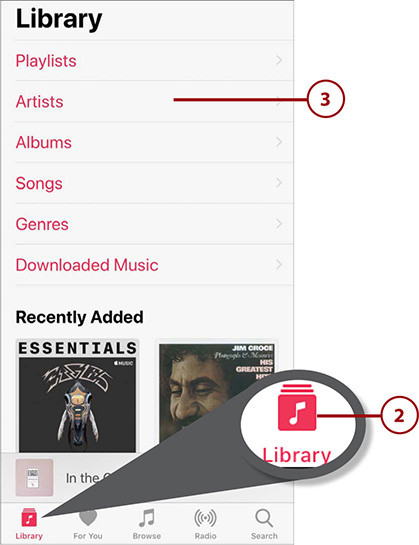
![]() Swipe up or down the list of artists to find the one you are interested in or tap the first letter of the artist’s name on the index (tap # for artists whose name starts with a number).
Swipe up or down the list of artists to find the one you are interested in or tap the first letter of the artist’s name on the index (tap # for artists whose name starts with a number).
![]() Tap the artist whose music you want to explore.
Tap the artist whose music you want to explore.

![]() Swipe up or down the screen to browse the artist’s music.
Swipe up or down the screen to browse the artist’s music.
![]() Tap an album to see its contents.
Tap an album to see its contents.

![]() Review and play the music you see (see “Playing Music” later in this chapter for details).
Review and play the music you see (see “Playing Music” later in this chapter for details).

Finding Songs
Finding specific songs to which you want to listen is also simple.
![]() Open the Music app.
Open the Music app.

![]() Tap Library. (Like other apps, Music remembers where you left off. If you don’t move directly to the main Library page, tap the Back icon (<) located in the upper-left corner of the screen until you move to that page.)
Tap Library. (Like other apps, Music remembers where you left off. If you don’t move directly to the main Library page, tap the Back icon (<) located in the upper-left corner of the screen until you move to that page.)
![]() Tap Songs. On the Songs screen, you see a list of all the songs in your library organized by artist and song title.
Tap Songs. On the Songs screen, you see a list of all the songs in your library organized by artist and song title.

![]() Tap Sort.
Tap Sort.

![]() Tap Title to have the songs sorted by title, Artist to have them sorted by the artist’s name, or Recently Added to put songs you’ve recently added at the top of the list. This example shows the Title option selected.
Tap Title to have the songs sorted by title, Artist to have them sorted by the artist’s name, or Recently Added to put songs you’ve recently added at the top of the list. This example shows the Title option selected.

![]() Swipe up or down the screen to browse songs.
Swipe up or down the screen to browse songs.
![]() To find a song by its title, tap the index on the first letter of the song’s or artist’s name and then swipe up or down the screen to find the song you want to hear.
To find a song by its title, tap the index on the first letter of the song’s or artist’s name and then swipe up or down the screen to find the song you want to hear.
![]() Tap the song you want to hear (see “Playing Music” later in this chapter for details).
Tap the song you want to hear (see “Playing Music” later in this chapter for details).

Other Library Categories
There are a number of other categories of music in your library. Playlists takes you to a list of your playlists. Albums shows you music grouped by album. Downloaded Music takes you to the music in your library that is currently stored on your iPhone so you can listen to it without an Internet connection. Home Sharing takes you to music you are sharing on a local network.
Change Your Library Categories
You can edit the categories you see in your library as well as adding different ones by tapping Edit. Then add categories, such as Composers or Genres, by tapping their circles, remove them by tapping their check marks, or reorganize them by dragging their List icons up or down the screen. When you’re done making changes, tap Done.
Setting Up and Finding Music with Apple Music
Apple Music is Apple’s subscription music service. Apple gives you the first three months for free to try it out, and after that you pay a monthly fee (currently $9.99 per month for an individual membership, $14.99 per month for a family membership of up to six people, or $4.99 for a student membership in the United States). The Apple Music Library is huge and you are likely to be able to find and listen to any music of interest to you. You can stream music to listen to it via the Internet or you can download it to your phone so that you don’t have to be connected to the Internet to hear it.
Apple Music provides suggestions to you for music you might enjoy based on the music you listen to, or search for, and based on music you indicate that you like by tapping the heart icon while you view or listen to it. Over time, these suggestions get more specific to your musical tastes so that Apple Music’s recommendations should help you discover and enjoy new music.
Apple Music is accessible on your iPhone, other iOS devices (such as an iPad), and any computer with the iTunes software on it. (Note that with a single membership, you can play Apple Music on only one device at a time.)
To access Apple Music, you must subscribe to the service.
Subscribing to Apple Music
You can subscribe to Apple Music as follows:
![]() Open the Music app.
Open the Music app.

![]() Tap For You.
Tap For You.
![]() Tap Try It Now.
Tap Try It Now.

![]() Tap the type of account you want to create (Individual, Family, or College Student).
Tap the type of account you want to create (Individual, Family, or College Student).
![]() Tap Start Trial.
Tap Start Trial.
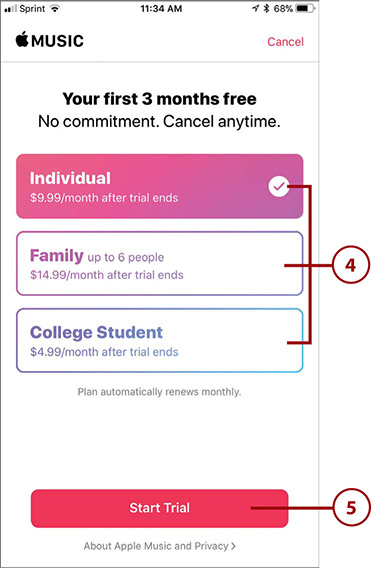
![]() Follow the onscreen instructions to complete the process by first selecting an existing Apple ID to use or creating a new one. After you’ve completed the process, Apple Music is enabled in the Music app and you see its options on the Dock at the bottom of the screen. (These steps are not shown in figures.)
Follow the onscreen instructions to complete the process by first selecting an existing Apple ID to use or creating a new one. After you’ve completed the process, Apple Music is enabled in the Music app and you see its options on the Dock at the bottom of the screen. (These steps are not shown in figures.)
Browsing Apple Music for You
For You music is music that Apple Music has selected for you (hence the name) based on what you have listened to, what is already in your music library, and what you indicate that you like (you learn how to do this later). To browse the music Apple Music has selected, perform the following steps:
![]() Open the Music app and tap For You. On the For You screen, you see a collection of playlists, albums, and songs that Apple Music recommends based on music you’ve listened to or that you indicated you like.
Open the Music app and tap For You. On the For You screen, you see a collection of playlists, albums, and songs that Apple Music recommends based on music you’ve listened to or that you indicated you like.
![]() Swipe up and down the screen to browse the selected music. It is organized in different categories, and the content of each category changes over time. The Recently Played section makes it easy to get back to music you’ve listened to recently.
Swipe up and down the screen to browse the selected music. It is organized in different categories, and the content of each category changes over time. The Recently Played section makes it easy to get back to music you’ve listened to recently.

![]() Explore the contents of a playlist or album by tapping its artwork. You see the list of songs in the collection you tapped.
Explore the contents of a playlist or album by tapping its artwork. You see the list of songs in the collection you tapped.

![]() Review and play the music you see (see “Playing Music” later in this chapter for details).
Review and play the music you see (see “Playing Music” later in this chapter for details).
![]() Tap Back (<) to return to the For You screen to browse for other music.
Tap Back (<) to return to the For You screen to browse for other music.

Browsing Apple Music
You can browse Apple Music to find music you want to hear.
![]() Tap Browse.
Tap Browse.
![]() Tap a category of music you want to browse, such as Genres.
Tap a category of music you want to browse, such as Genres.

![]() Swipe up and down to browse all the genres.
Swipe up and down to browse all the genres.
![]() Tap a genre to explore its contents.
Tap a genre to explore its contents.
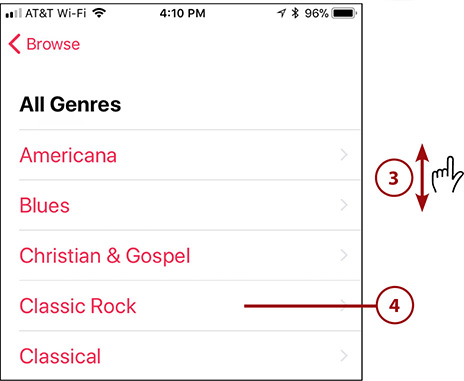
![]() Swipe up and down and left and right to browse all the content available.
Swipe up and down and left and right to browse all the content available.
![]() Tap a playlist, album, or other grouping to see the music it contains.
Tap a playlist, album, or other grouping to see the music it contains.

![]() Review and play the music you see (see “Playing Music” later in this chapter for details).
Review and play the music you see (see “Playing Music” later in this chapter for details).

Curated Playlist?
A curated playlist is one in which the music has been selected by a person (the curator) or a group of people (the curators). Other types of playlists are generated by software, such as a playlist based on a song you select; software then picks other songs that “go with” the selected song.
Adding Apple Music to Your Library
You can add Apple Music to your Library to make it easier to listen to again and so that it is downloaded to your iPhone so you can play it without an Internet connection. Here’s how:
![]() Using the information in the previous tasks, find Apple Music you want to add to your library.
Using the information in the previous tasks, find Apple Music you want to add to your library.
![]() To add all the songs you see to your Library, tap + ADD or to add an individual song to your library, tap Add (+). You see the Added confirmation pop up briefly and then all of the songs in the current collection or the individual songs download to your iPhone. When the process is complete, you see DOWNLOADED at the top of the screen.
To add all the songs you see to your Library, tap + ADD or to add an individual song to your library, tap Add (+). You see the Added confirmation pop up briefly and then all of the songs in the current collection or the individual songs download to your iPhone. When the process is complete, you see DOWNLOADED at the top of the screen.

In Your Library, but Not on Your iPhone
If you see a collection of music that has the download icon (a cloud with a downward-pointing arrow) instead of + ADD, that means the music is in your library but hasn’t been downloaded to your iPhone. When you listen to that music, it streams onto the phone, which requires an Internet connection. You can tap the download icon to download the music onto your iPhone.
Limited Data Plan?
If you have a limited data plan, you might want to disable music downloading when you are using a cellular Internet connection. Open the Settings app and tap Music. Tap Cellular Data. Use the controls on the Cellular Data screen to determine whether cellular data can be used at all (the Cellular Data switch), if it can be used for streaming, or if it can be used to download music. You also use the Cellular Data screen to choose if you want to use High Quality Streaming, a choice that provides the best listening option but also uses the most cellular data.
Limited Data Plan, Part II
If you have a limited data plan, you should consider downloading music if you think you’ll listen to it more than once. That way, you can play it from the copy stored on your iPhone rather than streaming it over your cellular connection. You can always delete any music on your iPhone that you no longer want, so there’s no downside to downloading it (especially if you download music when you are using a Wi-Fi network)—assuming your iPhone has plenty of free space of course.
Searching for Music
Searching for music enables you to quickly find music you want to hear. You can search music in your library or music available via Apple Music. To search for music, do the following steps:
![]() Open the Music app.
Open the Music app.

![]() Tap Search.
Tap Search.
![]() Tap a recent search to repeat that same search, and move to step 6.
Tap a recent search to repeat that same search, and move to step 6.
![]() Tap a trending search (one that other people are performing) to perform that search, and move to step 6.
Tap a trending search (one that other people are performing) to perform that search, and move to step 6.
![]() Tap in the Search bar to perform a new search.
Tap in the Search bar to perform a new search.

![]() Search the music in your library by tapping Your Library, or search Apple Music by tapping Apple Music.
Search the music in your library by tapping Your Library, or search Apple Music by tapping Apple Music.
![]() Type the term for which you want to search; this can be an artist’s name, song title, album title, lyrics, and so on. As you type, the results that meet your search term appear under the tabs.
Type the term for which you want to search; this can be an artist’s name, song title, album title, lyrics, and so on. As you type, the results that meet your search term appear under the tabs.
![]() Swipe up and down the screen to review the results of your search.
Swipe up and down the screen to review the results of your search.

![]() When you find something of interest, tap it. You move to that content’s page. What this contains depends on what you tapped on. For example, if you tap an album, you move to the album’s page. If you tap an artist, you move to a screen showing sections for top results, albums, songs, videos, and so on.
When you find something of interest, tap it. You move to that content’s page. What this contains depends on what you tapped on. For example, if you tap an album, you move to the album’s page. If you tap an artist, you move to a screen showing sections for top results, albums, songs, videos, and so on.
![]() Browse the content of what you tapped in step 9.
Browse the content of what you tapped in step 9.
![]() Tap See All to see all the items in a group, such as all albums (not shown in the figure).
Tap See All to see all the items in a group, such as all albums (not shown in the figure).
![]() Tap an album, song, or other item to view it.
Tap an album, song, or other item to view it.

![]() If you tapped an album, browse the songs it contains.
If you tapped an album, browse the songs it contains.
![]() Tap a song to play it.
Tap a song to play it.
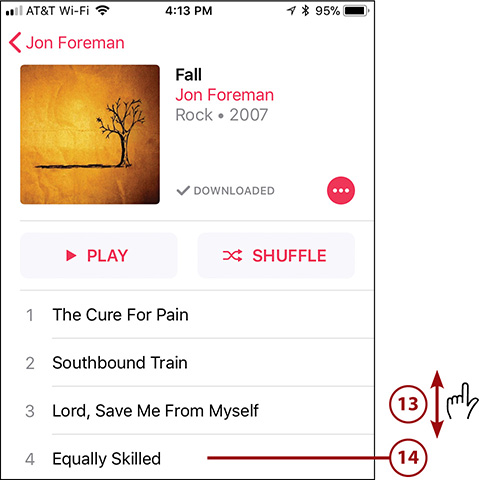
Playing Music

In the prior tasks, you learned how to find music to which you want to listen. No matter what you choose to listen to, such as a song, album, playlist, or other content, you use the same set of controls to listen to that music. When you find what you want to play, tap it to start it. The following sections describe several ways you can control music that is playing.
Playing Music on the Miniplayer

When you play music, the Miniplayer appears at the bottom of the screen. On this bar, you see the song currently playing and the art associated with the song playing. You also see the Pause/Play icon that you can tap to stop or start the music.
While the Miniplayer appears, you can use the upper part of the Music app’s screen to find other music to listen to, to download more music, and so on. The Miniplayer remains on the screen as long as music plays so you can control what is playing while you are doing other things with the app.
To have more control over the music and to see other options, tap the Miniplayer. The Now Playing screen opens.
Playing Music on the Now Playing Screen

The Now Playing screen has many features, including:
Timeline—Just below the art, you see the timeline. The elapsed time is on the left side, and the remaining time is on the right. The Playhead shows you where you are in the song. You can drag this to the left to move back in the song or to the right to move ahead.
Song information—Below the timeline is the song’s name (in larger, bold font). Under that is the artist and album title. If any of this information is too large to fit on the screen, it scrolls across the screen to display it all.
Previous/Rewind—If the current song has been playing for more than a second or two, tap this icon once to move to the beginning of the current song. If you are at the beginning of the current song, tap it to move to the previous song in the current source (album, artist, and so on). Tap and hold to rewind in the current song.
Pause/Play—Tap Pause to pause the song. Tap Play to play it again.
Next/Fast-Forward—Tap once to move to the next song on the list (or the next randomly selected song, if you are shuffling). Tap and hold to fast-forward in the current song.
Volume—Drag the slider to the left to lower the volume or to the right to increase it.
Output device—Tap this icon to change where music is playing. When you tap this, a menu showing all the options appears. For example, if you have Bluetooth speakers paired with your iPhone, you can tap them to play the music there. If you have devices connected via AirPlay, such as an Apple TV, you can tap them to use them to listen to music. If you have EarPods connected to your iPhone, you can choose to play music over them. To return playback to the iPhone’s speakers, tap iPhone.
Options (…)—Whenever you see the Options icon (…), you can tap it to open a menu of commands as described in the following text and figure.
When you open an item’s menu by tapping the Options (…) icon, you see a menu of commands for that item. The commands you see depend on the item you are viewing at the time. For example, you see a different set of commands for an album than you do for an iTunes radio station. Also, the status of the item affects the commands you see. If you are viewing Apple Music that has been added to your library, you see the Remove command, which enables you to remove the music; if you are viewing music that hasn’t been added, you see the Add to Library command instead.
Following is an example of this menu for an album that is part of my library. If you tap an action on the menu, it is performed. If you don’t want to take an action, tap Cancel, and you move back to the prior screen.

To collapse the Now Playing screen, swipe down from or tap the top of the Now Playing screen. You return to the Miniplayer.
Turn It Up! (Or Down!)
No matter which technique you use to find and play music, you can control the volume using the Volume buttons on the left side of your iPhone. Press the upper button to increase volume or the lower one to decrease it. While you are pressing a button, a volume indicator appears on the screen to show you the relative volume level as you press the buttons. When you are on the Now Playing screen or viewing the Music control bar (covered later in this chapter), you can also use the Volume slider to set the sound level. If you listen with the EarPods included with your iPhone, you can use the buttons on the right EarPod’s wire to crank it up (press and hold the top button) or down (press and hold the bottom button).
Sleep Timer
Here’s a tip courtesy of my acquisitions editor. To cause your music to stop playing after a specific period of time, open the Control Center, tap the Clock icon, and then tap Timer. Use the wheels to set the amount of time that you want the music to play. Tap When Timer Ends. Swipe up the screen and tap Stop Playing. Tap Set at the top right of the screen then tap Start. When the timer expires, the music stops.
Playing Music from the Lock Screen

When audio is playing and your iPhone is locked, you can control music playback right from the Lock screen.
When you wake your phone, you see the Lock screen that displays information about and controls for the music currently playing. Use the controls you see; these work like they do in the Music app.
When you’re done controlling the tunes, press the Side button to put your phone to sleep again to prevent the controls from being on the screen (so that they don’t accidentally get activated if you put your iPhone back in your pocket, for example).
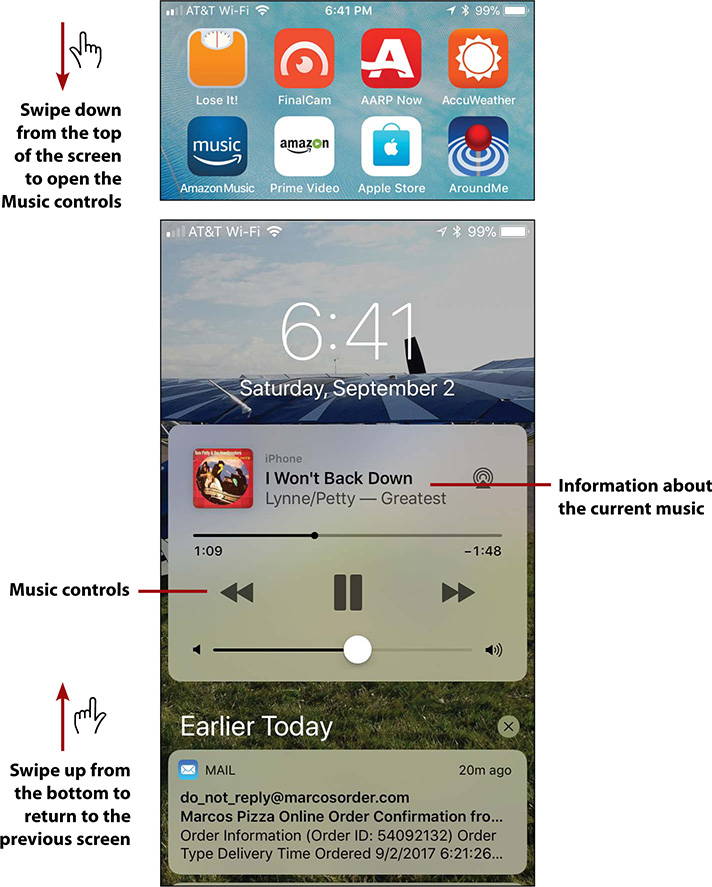
If your phone is unlocked, you can open the same tool by swiping down from the top of the screen. You see the same music controls as on the Lock screen. The Notification Center is under those controls; you can swipe up and down the list of notifications to review them. Swipe up from the bottom of the screen to return to the previous screen.
Playing Music from the Control Center

To get to some of the music controls quickly, open the Control Center. In the upper-right corner of the Control Center, you see Audio tools. Press and hold on this area to open the same set of music controls as you see on the Lock screen. When you’re done, tap outside the music controls to return to the Control Center. Use the controls you see; then, close the Control Center and continue what you were doing.
More Than Just Music
The controls in the Audio section of the Control Center change based on the app you are using to play audio. For example, when you are using the Podcasts app to play a podcast, these tools control the podcast’s playback. Likewise, if you play audio with a different app, these controls work for that app.
Siri and Music
You can use Siri to select, play, and control music, too. For example, you can activate Siri and say “Play album Frank Sinatra’s Greatest Hits” to play that album or “Play Song ‘Free Bird’” to play that song. You can say, “Show me music by Switchfoot” to see music by that group. Refer to Chapter 11, “Working with Siri,” for details.
Using 3D Touch with the Music App (iPhone 6s/6s Plus and Later)
Like other default iPhone apps, the Music app supports 3D Touch, which you can use in a couple of ways.


When you press on the Music app’s icon, you see the Quick Actions menu. At the bottom of this menu, you see the Music widget displaying music you have played recently; tap an album cover or playlist art to play its music. You can tap Play Beats 1 to play that music or tap Search to jump to the search screen.

When you are browsing music, press on music in which you are interested to perform a Peek on it. In the Peek window, you view the music on which you pressed and you see a menu of commands. Tap a command to perform it. For example, tap the Play icon to play the music you are viewing.
Finding Your Way with Maps
The Maps app enables you to find locations and view them on the map. However, the real power of the Maps app is that you can then get detailed, turn-by-turn, voice directions to those places. You can use these directions to drive, walk, take public transportation, or even connect to a ride-share service (such as Lyft) to the places you find. Maps monitors your path; when there are issues that might be a problem, such as heavy traffic or an accident, the app attempts to reroute you to a better way.
Generating directions with the Maps app is easy and quick to do as the following steps demonstrate:
![]() On the Home screen, tap Maps.
On the Home screen, tap Maps.

![]() Tap in the Search bar.
Tap in the Search bar.

![]() Type in the location you want to find. You can type in an address, a place name (such as Indianapolis Executive Airport), or even a description of what you are looking for (for example, coffee). As you type, the app presents a list of locations that meet your search. Keep typing until you see the location you want to find on the list; if it isn’t a public location, such as somebody’s home or a business, you will probably have to type the entire address.
Type in the location you want to find. You can type in an address, a place name (such as Indianapolis Executive Airport), or even a description of what you are looking for (for example, coffee). As you type, the app presents a list of locations that meet your search. Keep typing until you see the location you want to find on the list; if it isn’t a public location, such as somebody’s home or a business, you will probably have to type the entire address.
![]() Tap the location you want to see on the map. The map appears and the location, or locations (if you do a more general search), for which you searched are marked with a pushpin. (If you found multiple locations, tap the one to which you want to navigate.)
Tap the location you want to see on the map. The map appears and the location, or locations (if you do a more general search), for which you searched are marked with a pushpin. (If you found multiple locations, tap the one to which you want to navigate.)

![]() To get directions to the selected location, tap Directions.
To get directions to the selected location, tap Directions.
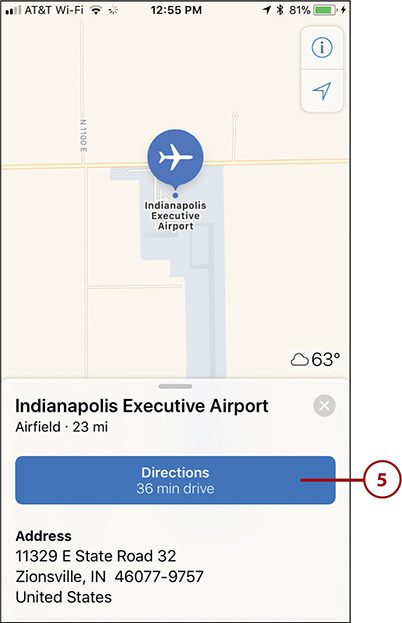
Don’t Want to Get There from Here?
Maps assumes you want a path from your current location to the destination you selected. However, you can choose a different starting point by tapping My Location. Use the Change Route screen to search for and select a different starting location. Tap Route. Maps updates the route to start from the location you selected on the Change Route screen.
![]() Tap how you want to travel to the destination, such as Drive, Walk, and so on. The options you see depend on where you are going and where you are. The app generates alternative paths when possible. The primary or default path is shown in dark blue; alternative paths are in light blue. You see a time estimate for each path.
Tap how you want to travel to the destination, such as Drive, Walk, and so on. The options you see depend on where you are going and where you are. The app generates alternative paths when possible. The primary or default path is shown in dark blue; alternative paths are in light blue. You see a time estimate for each path.
You might also see paths or parts of paths in yellow or red. These colors indicate there is some kind of trouble along that route; red indicates a potentially longer slowdown than yellow. That trouble could be a slowdown due to an accident or heavy traffic. The length of the yellow or red segment can help you decide which route to take. If a route has large yellow or red segments, consider taking a different route.
![]() If you want to follow an alternate path, tap it. Maps regenerates the route.
If you want to follow an alternate path, tap it. Maps regenerates the route.
![]() Tap Go. The app shows you the part of the route you are on and announces what you need to do.
Tap Go. The app shows you the part of the route you are on and announces what you need to do.

![]() Follow the verbal or onscreen directions to start your journey. Maps shows you where you are on your route and what is coming next. As you approach the next step, such as a turn, the app starts to make announcements about what you need to do.
Follow the verbal or onscreen directions to start your journey. Maps shows you where you are on your route and what is coming next. As you approach the next step, such as a turn, the app starts to make announcements about what you need to do.

![]() Listen for the app’s instructions about the next step and follow the directions you hear.
Listen for the app’s instructions about the next step and follow the directions you hear.

![]() To get more information or find interim locations (such as gas stations or restaurants), swipe up from the top of the gray section at the bottom of the screen (if you are using an X model and swipe up from the bottom of the screen, you move to a Home screen instead).
To get more information or find interim locations (such as gas stations or restaurants), swipe up from the top of the gray section at the bottom of the screen (if you are using an X model and swipe up from the bottom of the screen, you move to a Home screen instead).

![]() Tap the kind of service you need, such as Coffee (other options can include Gas Stations, Lunch, Breakfast, Dinner, or Restaurants depending on your location and time of day). Maps locates services of that type that are “convenient” to your path and presents options on the map and in the panel at the bottom of the screen.
Tap the kind of service you need, such as Coffee (other options can include Gas Stations, Lunch, Breakfast, Dinner, or Restaurants depending on your location and time of day). Maps locates services of that type that are “convenient” to your path and presents options on the map and in the panel at the bottom of the screen.

![]() Swipe up and down on the list of options to review how far away from you they are and how much time will be added to the trip if you go to those locations.
Swipe up and down on the list of options to review how far away from you they are and how much time will be added to the trip if you go to those locations.
![]() To navigate to one of the locations on the list, tap GO. Maps reroutes you to that location. (After you arrive at that location, Maps prompts you to resume your previous route.)
To navigate to one of the locations on the list, tap GO. Maps reroutes you to that location. (After you arrive at that location, Maps prompts you to resume your previous route.)
![]() If you don’t want to choose one of the locations and just return to the directions to the original location, tap Done.
If you don’t want to choose one of the locations and just return to the directions to the original location, tap Done.

![]() If you move out of the Maps app, you can tap the blue oval (X models) or bar (non-X models) at the top of the screen to return to it. When the next step in your path approaches, you see that step in a pop-up box on the screen.
If you move out of the Maps app, you can tap the blue oval (X models) or bar (non-X models) at the top of the screen to return to it. When the next step in your path approaches, you see that step in a pop-up box on the screen.

![]() Continue following the directions until you arrive at your destination.
Continue following the directions until you arrive at your destination.
![]() Tap End Route to reset Maps.
Tap End Route to reset Maps.

Managing Your Health Information with the Health App
Apple’s Health app does two things. One is that you can use it to store a Medical ID with your medical information in one place for easy access, for your reference or for the reference of others during an emergency. The other is that it can be a dashboard for other health-related apps you use. For example, if you use an app to help you lose weight, that app can provide information to the Health app. Likewise, apps you use to monitor your exercise can feed their results to the Health app so you can get all your health information in one place.
You can also configure and use the Emergency SOS feature to get help quickly.
Configuring and Using Emergency Calling
Using the Emergency SOS feature, you can quickly place a call to local emergency services and also send notifications to people to let them know an emergency has occurred. To be able to use this feature, you need to configure it as explained in the next section. Once configured, you can call for help and notify others as explained in “Using Emergency Calling.”
Configuring Emergency Calling
To configure emergency calling, perform the following steps:
![]() Open the Settings app.
Open the Settings app.

![]() Tap Emergency SOS.
Tap Emergency SOS.

![]() Note how you activate an emergency call using the diagram at the top of the screen. This shows the specific buttons you push and the number of times you push them to place the emergency call. For example, on an X model, you press and hold the Side and either Volume button to activate an emergency call.
Note how you activate an emergency call using the diagram at the top of the screen. This shows the specific buttons you push and the number of times you push them to place the emergency call. For example, on an X model, you press and hold the Side and either Volume button to activate an emergency call.
![]() If you are using an X model, set the Call with Side button switch to on (green) if you want to be able to activate a call by quickly pressing the Side button five times.
If you are using an X model, set the Call with Side button switch to on (green) if you want to be able to activate a call by quickly pressing the Side button five times.
![]() Set the Auto Call switch to on (green). If you don’t do this, the emergency call won’t be automatically placed.
Set the Auto Call switch to on (green). If you don’t do this, the emergency call won’t be automatically placed.
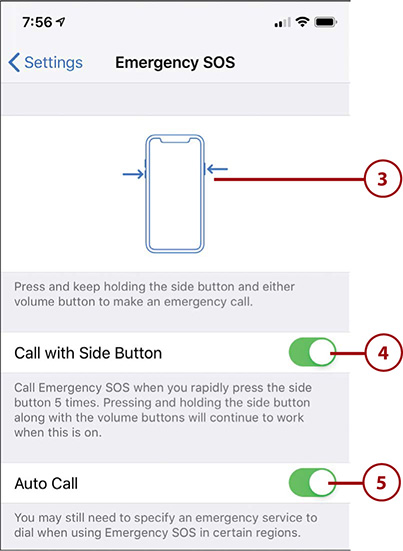
![]() Tap Edit Emergency Contacts in Health to identify who you want to be notified when you place an emergency call. The details for this are provided in “Using the Health App to Create a Medical ID” later in this chapter.
Tap Edit Emergency Contacts in Health to identify who you want to be notified when you place an emergency call. The details for this are provided in “Using the Health App to Create a Medical ID” later in this chapter.
![]() Set the Countdown Sound switch to on (green) so you hear a warning sound before the call is placed. This can help prevent accidental emergency calls because you hear the alert before the call is made.
Set the Countdown Sound switch to on (green) so you hear a warning sound before the call is placed. This can help prevent accidental emergency calls because you hear the alert before the call is made.

Emergency Contact Number
The number you should call for emergency services depends on your specific location. These steps cover someone in the United States or other locations with a national emergency calling system. If where you are doesn’t have this type of system, search for how to use Emergency SOS in your area on Apple’s support site located at www.apple.com/support.
Using Emergency Calling
With Emergency SOS set up as described in the previous section, you can place an emergency call and send notifications using the following steps:
![]() Press the button sequence to activate Emergency SOS that you noted in step 3 of the previous task. For example, on an iPhone 7 or earlier model, you press the Side button five times; on an iPhone 8, 8 Plus, or X you press the Side button and either Volume button or the Side button five times (if you enabled that option). The Emergency SOS feature activates, starts a timer, and plays the alert sound.
Press the button sequence to activate Emergency SOS that you noted in step 3 of the previous task. For example, on an iPhone 7 or earlier model, you press the Side button five times; on an iPhone 8, 8 Plus, or X you press the Side button and either Volume button or the Side button five times (if you enabled that option). The Emergency SOS feature activates, starts a timer, and plays the alert sound.
When the call is made, you are connected to your local emergency services just as if you placed the call manually. Notifications are also sent to your emergency contacts to inform them you have made an emergency call.
![]() If you didn’t intend to place the call, tap the Stop icon before the timer finishes its countdown.
If you didn’t intend to place the call, tap the Stop icon before the timer finishes its countdown.
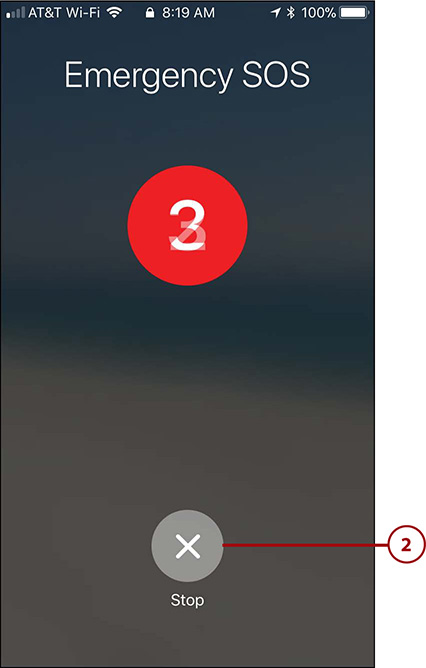
Using the Health App to Create a Medical ID
To configure a Medical ID in the Health app, perform the following steps:
![]() Tap Health to open the app.
Tap Health to open the app.
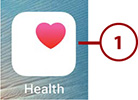
![]() Tap Create Medical ID. You see that your name and photo (if you added one) is filled in automatically based on other configurations, such as the photo set for your Apple ID. (If your name or photo isn’t entered automatically, enter at least your name; you should also add a photo so emergency workers can confirm your identity.)
Tap Create Medical ID. You see that your name and photo (if you added one) is filled in automatically based on other configurations, such as the photo set for your Apple ID. (If your name or photo isn’t entered automatically, enter at least your name; you should also add a photo so emergency workers can confirm your identity.)
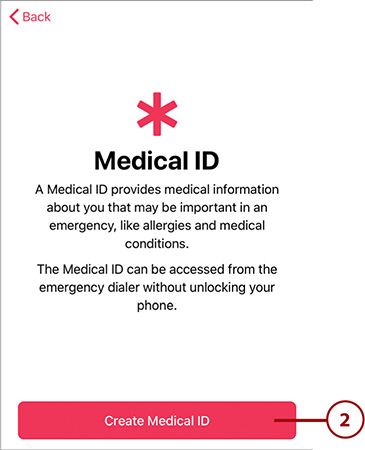
![]() Set the Show When Locked switch to on (green) so that you or others can access your medical information when your iPhone is locked. For example, if someone needs to provide you with medical treatment, they can get to this information without having to unlock your phone.
Set the Show When Locked switch to on (green) so that you or others can access your medical information when your iPhone is locked. For example, if someone needs to provide you with medical treatment, they can get to this information without having to unlock your phone.
![]() Tap in the Date of Birth area and use the wheels to set your date of birth.
Tap in the Date of Birth area and use the wheels to set your date of birth.
![]() Swipe up the screen on the Date of Birth area to close it.
Swipe up the screen on the Date of Birth area to close it.

Only the First Time
Step 2 applies only the first time you open the Health app. To update your information after you’ve started using the app, open the Health app and tap the Medical ID icon on the Dock. Tap Edit and use these steps to change the information on your Medical ID.
Not the First Time
If there is health or identification information on your iPhone, you might see a review of that information when you first open the Health app. If so, review and edit this information as needed and tap the Next button until you see the screen shown in step 2.
![]() Tap the next information you want to include.
Tap the next information you want to include.

![]() Enter the information.
Enter the information.
![]() Tap in the next section and enter its information.
Tap in the next section and enter its information.
![]() When you’re done entering the information in the text fields, swipe up the screen to close the keyboard.
When you’re done entering the information in the text fields, swipe up the screen to close the keyboard.

![]() Complete the other fields you see.
Complete the other fields you see.
![]() Tap add emergency contact.
Tap add emergency contact.

![]() Use the Contacts app to select the emergency contact (see Chapter 6, “Managing Contacts,” for help with this app).
Use the Contacts app to select the emergency contact (see Chapter 6, “Managing Contacts,” for help with this app).

![]() Tap the relationship you have with the contact you selected in the prior step.
Tap the relationship you have with the contact you selected in the prior step.

![]() Continue adding information and emergency contacts until you’ve provided all the information you want to have available on your Medical ID.
Continue adding information and emergency contacts until you’ve provided all the information you want to have available on your Medical ID.
![]() When you’ve completed your Medical ID, tap Done.
When you’ve completed your Medical ID, tap Done.

Accessing Your Medical ID

You can view your Medical ID information at any time by returning to the Medical ID screen (open the Health app and tap Medical ID).

If you enabled the Show When Locked feature in step 3 of the previous task, your Medical ID can be accessed while your iPhone is locked. This is especially useful for situations in which you are incapacitated and others need this information to treat you. To access this information while the phone is locked, wake up the phone, but don’t unlock it. (For example, if you are using Face ID, you need to point the screen away from you when you wake the phone, or it unlocks automatically. Of course, emergency responders won’t be able to unlock your phone, so undesired unlocking won’t be an issue for them.) Tap Emergency; then, tap Medical ID. Your information is displayed along with your emergency contacts who can be called by tapping their phone numbers.
Using the Health App for Health and Fitness Information
You can use the Health app to store all sorts of health and related information. This information can be entered directly into the Health app, or even more usefully, it can be automatically added from other apps you use, such as an app you use to monitor exercise or to lose weight.
Finding and Installing Health Apps
You can use the information in Chapter 4 to find and download health-related apps from the App Store. As you consider apps you might want to use, make sure they are compatible with the Health app; if an app is described as working with the Healthkit or Apple Health compatible, it can report its information to the Health app. You need to install these apps on your iPhone so they can work with the Health app. To get information about apps that can work with the iPhone’s Health app, do a web search for “apps that work with the health app.” Or, search the App Store for “Healthkit.” When you find apps you want to use, download and install them as detailed in Chapter 4.
Configuring Apps to Report to the Health App
You have to provide explicit permission for apps to report their data to the Health app so that you can view that information on the Health app’s screens. You can do this using the Health app by performing the following steps:
![]() If it isn’t open already from the previous task, open the Health app by tapping its icon on a Home screen (not shown on a figure).
If it isn’t open already from the previous task, open the Health app by tapping its icon on a Home screen (not shown on a figure).
![]() Tap Sources.
Tap Sources.
From the App
In some cases, you might need to enable connection between the other app and the Health app by using the other app. Open the app you want to connect to the Health app and move into its Settings area. Look for the settings associated with the Health app and set them to on. When you do that, the app should appear on the Sources page and you can configure it as described here.
![]() Tap the app you want to configure.
Tap the app you want to configure.

![]() If you want all the data that the app can report to be reported into the Health app, tap Turn All Categories On.
If you want all the data that the app can report to be reported into the Health app, tap Turn All Categories On.

![]() To enable specific data to be reported in the Health app, set its switch to on (green) or to prevent that data from being reported, set its switch to off (white).
To enable specific data to be reported in the Health app, set its switch to on (green) or to prevent that data from being reported, set its switch to off (white).
![]() Tap the Back icon (<) and repeat steps 3 through 5 until you’ve configured all the apps whose data you want to access in the Health app.
Tap the Back icon (<) and repeat steps 3 through 5 until you’ve configured all the apps whose data you want to access in the Health app.

Using the Health App to View Health Information
You can use the Health app to view your health information. Because it consolidates the information from many other apps, there is a large amount of information available to you. You can view information in individual categories and view dashboards and data of specific types.
To see your information, open the Health app and use the following pointers to get started:
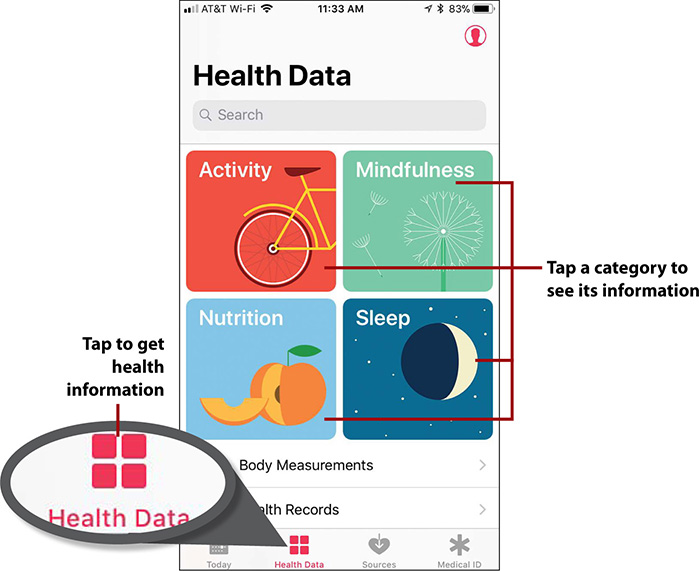
Tap Health Data. You see categories at the top of the screen, such as Activity and Nutrition. Tap a category to view the information it contains. For example, when you tap Activity, you see information about the workouts you’ve done, which have been reported by other apps or captured by the iPhone itself. You can see information for the current week or year. You also see apps related to exercise along with data that’s been collected for various kinds of exercise or by specific apps. Tap Health Data to get back to the Health Data screen.

On the Health Data screen, swipe up to view different kinds of data, such as Body Measurements or Heart. For example, if you tap Heart, you see a chart of heart data including heart rate. At the bottom of the screen, you can access other data, such as for blood pressure, or set up notifications, for example, to receive a notification when the heart rate exceeds a threshold value.
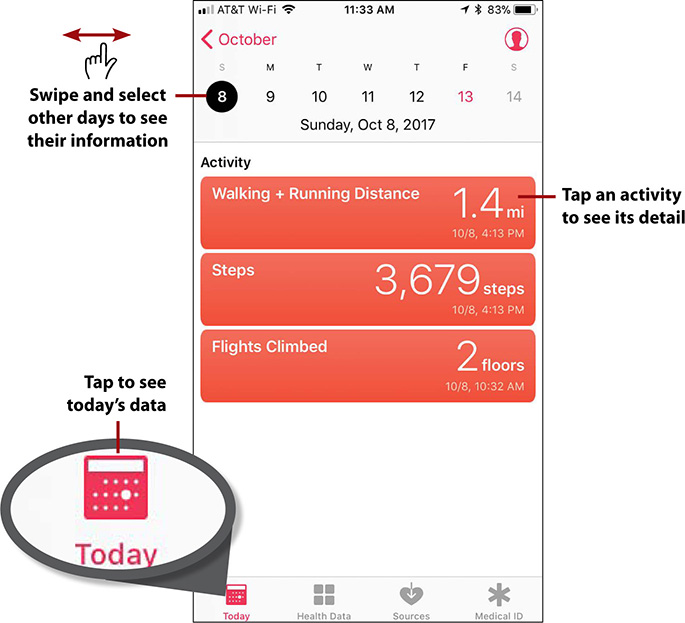
Tap Today. You see the information collected, such as for activities that happened on that day. You can tap an activity to see its details. You can swipe on the dates at the top of the screen to select other days to view.
Configuring Health Devices
Some health devices can report their information directly into their apps, which can in turn report that data into the Health app. (Your iPhone can track your steps and report those to the Health app.) First, if necessary, pair the device with your iPhone (see the next section for details). Second, open the Settings app, tap Privacy, and then tap Motion & Fitness. Use the settings on the Motion & Fitness screen to enable Fitness Tracking and to enable apps to access your Motion & Fitness activity. If you set the Fitness Tracking switch to on (green), the iPhone can track and report on data collected with other devices, such as an activity tracker. This data is available in the Health app, too.
Using Bluetooth to Connect to Other Devices
The iPhone includes built-in Bluetooth support so you can use this wireless technology to connect to other Bluetooth-capable devices. The most likely devices to connect to your iPhone in this way are Bluetooth headphones (such as Apple AirPods), speakers, headsets, or car audio/entertainment/information systems, but you can also use Bluetooth to connect to other kinds of devices, most notably keyboards.
To connect Bluetooth devices together, you pair them. In Bluetooth, pairing enables two Bluetooth devices to communicate with each other. The one constant requirement is that the devices can communicate with each other via Bluetooth. For devices to find and identify each other so they can communicate, one or both must be discoverable, which means they broadcast a Bluetooth signal other devices can detect and connect to.
There is also a “sometimes” requirement, which is a pairing code, passkey, or PIN. All those terms refer to the same thing, which is a series of numbers, letters, or both, entered on one or both devices being paired. Sometimes you enter this code on both devices, whereas for other devices you enter the first device’s code on the second device. Some devices, such as headphones or speakers, don’t require a pairing code at all.
When you have to pair devices, you’re prompted to do so, and you have to complete the actions required by the prompts to communicate via Bluetooth. This might be just tapping Connect, or you might have to enter a passcode on one or both devices to connect them.
Connecting to Bluetooth Devices
This task demonstrates pairing an iPhone with Bluetooth headphones; you can pair it with other devices similarly.
![]() Move to the Settings screen. The current status of Bluetooth on your iPhone is shown.
Move to the Settings screen. The current status of Bluetooth on your iPhone is shown.
![]() Tap Bluetooth.
Tap Bluetooth.

![]() If Bluetooth isn’t on (green), tap the Bluetooth switch to turn it on. If it isn’t running already, Bluetooth starts up. The iPhone immediately begins searching for Bluetooth devices. You also see the status Now Discoverable, which means other Bluetooth devices can discover the iPhone. In the MY DEVICES section, you see devices to which you’ve previously paired your iPhone; their current status is either Connected, meaning the device is currently communicating with your iPhone, or Not Connected, meaning the device is paired with your iPhone, but is not currently connected to it. In the OTHER DEVICES section, you see the devices that are discoverable to your iPhone but that are not paired with it.
If Bluetooth isn’t on (green), tap the Bluetooth switch to turn it on. If it isn’t running already, Bluetooth starts up. The iPhone immediately begins searching for Bluetooth devices. You also see the status Now Discoverable, which means other Bluetooth devices can discover the iPhone. In the MY DEVICES section, you see devices to which you’ve previously paired your iPhone; their current status is either Connected, meaning the device is currently communicating with your iPhone, or Not Connected, meaning the device is paired with your iPhone, but is not currently connected to it. In the OTHER DEVICES section, you see the devices that are discoverable to your iPhone but that are not paired with it.
![]() If the device you want to use isn’t shown in the OTHER DEVICES section, put it into Discoverable mode. (Not shown; see the instructions provided with the device.) When it is discoverable, it appears in the OTHER DEVICES section.
If the device you want to use isn’t shown in the OTHER DEVICES section, put it into Discoverable mode. (Not shown; see the instructions provided with the device.) When it is discoverable, it appears in the OTHER DEVICES section.
![]() Tap the device to which you want to connect. If the device isn’t currently paired with your iPhone, you might need to provide a passkey. If a passkey is required, you see a prompt to enter it on the device with which you are pairing; perform step 6. If no passkey is required, skip to step 7.
Tap the device to which you want to connect. If the device isn’t currently paired with your iPhone, you might need to provide a passkey. If a passkey is required, you see a prompt to enter it on the device with which you are pairing; perform step 6. If no passkey is required, skip to step 7.

![]() If it is required, input the pairing code, passkey, or PIN on the device (not shown in a figure), such as typing the passkey on a keyboard if you are pairing your iPhone with a Bluetooth keyboard.
If it is required, input the pairing code, passkey, or PIN on the device (not shown in a figure), such as typing the passkey on a keyboard if you are pairing your iPhone with a Bluetooth keyboard.
![]() If required, tap Connect (not shown in a figure)—some devices connect as soon as you select them or enter the passkey and you won’t need to do this. You see the device to which the iPhone is connected in the MY DEVICES section of the Bluetooth screen, and its status is Connected, indicating that your iPhone can communicate with and use the device.
If required, tap Connect (not shown in a figure)—some devices connect as soon as you select them or enter the passkey and you won’t need to do this. You see the device to which the iPhone is connected in the MY DEVICES section of the Bluetooth screen, and its status is Connected, indicating that your iPhone can communicate with and use the device.
![]() To manage a device, tap its Info icon.
To manage a device, tap its Info icon.

![]() Tap the command you want to use; for example, to stop working with a device, tap Disconnect. The options you see depend on the device and its current status.
Tap the command you want to use; for example, to stop working with a device, tap Disconnect. The options you see depend on the device and its current status.
When your iPhone is paired with a device that supports audio, such as headphones, you can open the device menu (such as the one on the Audio controls panel) and tap the device on which you want to hear that audio.

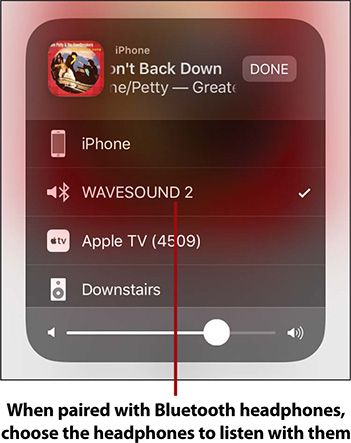
Connecting Your iPhone to Other iPhones, iPod touches, or iPads
The iPhone (and other devices that run the iOS software, including iPod touches and iPads) supports peer-to-peer connectivity, which is the technical way of saying that these devices can communicate with one another directly via a Wi-Fi network or Bluetooth. This capability is used in a number of apps, especially multiplayer gaming, for information sharing, and for other collaborative purposes.
If the app you want to use communicates over a Wi-Fi network, such as a network you use to access the Internet, all the devices with which you want to communicate must be on that same network. If the application uses Bluetooth, you must enable Bluetooth on each device and pair them (as described in the previous task) so they can communicate with one another.
The specific steps you use to connect to other iOS devices using a collaborative app depend on the specific app you are using. The general steps are typically as follows:
Ensure the devices can communicate with each other. If the app uses Wi-Fi, each device must be on the same Wi-Fi network. If the app uses Bluetooth, the devices must be paired.
Each person opens the app on his device.
Use the app’s controls to select the devices with which you’ll be collaborating. Usually, this involves a confirmation process in which one person selects another person’s device and that person confirms that the connection should be allowed.
Use the app’s features to collaborate. For example, if the app is a game, each person can interact with the group members. Or, you can directly collaborate on a document with all parties providing input into the document.
Using AirDrop to Share Content with Other iPhones, iPod touches, iPads, or a Mac
You can use the AirDrop feature to share content directly with people using a Mac running OS X Yosemite or later, or using a device running iOS 7 or later. For example, if you capture a great photo on your iPhone, you can use AirDrop to instantly share that photo with iOS device and Mac users near you.
AirDrop can use Wi-Fi or Bluetooth to share, but the nice thing about AirDrop is that it manages the details for you. You simply open the Share menu—which is available in most apps—tap AirDrop, and tap the people with whom you want to share.
When you activate AirDrop, you can select Everyone, which means you see anyone who has a Mac running OS X Yosemite or later, or an iOS device running version iOS 7 or newer and is on the same Wi-Fi network as you (or has a paired Bluetooth device); those people can see you, too. (You can decline any request to share with you via AirDrop so even if you choose Everyone, you can still decide which content is moved onto your iPhone.) Or, you can select Contacts Only, which means only people who are in your Contacts app are able to use AirDrop to communicate with you. In most cases, you should choose the Contacts Only option so you have more control over who uses AirDrop with you.
Is AirDrop Safe?
Anything you share with AirDrop is encrypted, so the chances of someone else being able to intercept and use what you share are quite low. Likewise, you don’t have to worry about someone using AirDrop to access your information or to add information to your device without your permission. However, like any networking technology, there’s always some chance—quite small in this case—that someone will figure out how to use this technology for nefarious purposes. The best thing you can do is to be wary of any requests you receive to share information and ensure they are from people you know and trust before you accept them.
Enabling AirDrop
To use AirDrop, you must enable it on your iPhone.
![]() Open the General screen of the Settings app.
Open the General screen of the Settings app.
![]() Tap AirDrop.
Tap AirDrop.

![]() Tap Receiving Off if you don’t want to receive any content via AirDrop (you can still share your content with others), tap Contacts Only to allow only people in your Contacts app to be able to request to share content with you, or Everyone to allow anyone using a device running iOS 7 or later or a Mac running OS X Yosemite or later in your area to request to share content with you.
Tap Receiving Off if you don’t want to receive any content via AirDrop (you can still share your content with others), tap Contacts Only to allow only people in your Contacts app to be able to request to share content with you, or Everyone to allow anyone using a device running iOS 7 or later or a Mac running OS X Yosemite or later in your area to request to share content with you.

Another Way to Configure AirDrop
You can also configure AirDrop by opening the Control Center and pressing on the Airplane mode, Wi-Fi, Cellular Data, or Bluetooth icons. On the resulting panel, tap the AirDrop icon. Then choose the AirDrop status you want to set (these are the same as described in step 3).
Share and Share Alike?
You should choose the Receiving Off option when you aren’t using AirDrop, especially if you usually use the Everyone option. By disabling it, you avoid having people in your area be able to try to communicate with you without you wanting them to do so. When you want to receive content again, you can quickly reset AirDrop to Contacts Only or Everyone again.
Using AirDrop to Share Your Content
To use AirDrop to share your content, do the following:
![]() Open the content you want to share. This example shows sharing a photo using the Photos app (this app is covered in detail in Chapter 14, “Viewing and Editing Photos and Video with the Photos App”). The steps to share content from any other app are quite similar.
Open the content you want to share. This example shows sharing a photo using the Photos app (this app is covered in detail in Chapter 14, “Viewing and Editing Photos and Video with the Photos App”). The steps to share content from any other app are quite similar.
![]() Tap the Share icon.
Tap the Share icon.
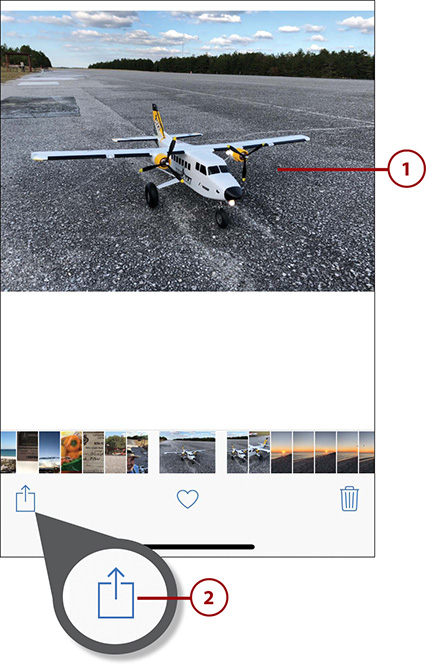
![]() If the app you selected in step 1 supports it, you can swipe to preview other content and select it by tapping it. Each item you select is available for sharing. When marked with the check mark, the content will be shared.
If the app you selected in step 1 supports it, you can swipe to preview other content and select it by tapping it. Each item you select is available for sharing. When marked with the check mark, the content will be shared.
![]() Tap AirDrop (not shown on the figure) or just wait a couple of seconds. The AirDrop icon is replaced with icons for each person in your area who has AirDrop enabled that you have permission to access (such as being in her Contacts app if she is using the Contacts Only option).
Tap AirDrop (not shown on the figure) or just wait a couple of seconds. The AirDrop icon is replaced with icons for each person in your area who has AirDrop enabled that you have permission to access (such as being in her Contacts app if she is using the Contacts Only option).
![]() Swipe to the left or right to browse all the people with whom you can share.
Swipe to the left or right to browse all the people with whom you can share.
![]() Tap the people with whom you want to share the content. A sharing request is sent to those people’s devices. Under their icons, the Waiting status is displayed. When a recipient accepts your content, the status changes to Sent. If a recipient rejects your content, the status changes to Declined.
Tap the people with whom you want to share the content. A sharing request is sent to those people’s devices. Under their icons, the Waiting status is displayed. When a recipient accepts your content, the status changes to Sent. If a recipient rejects your content, the status changes to Declined.
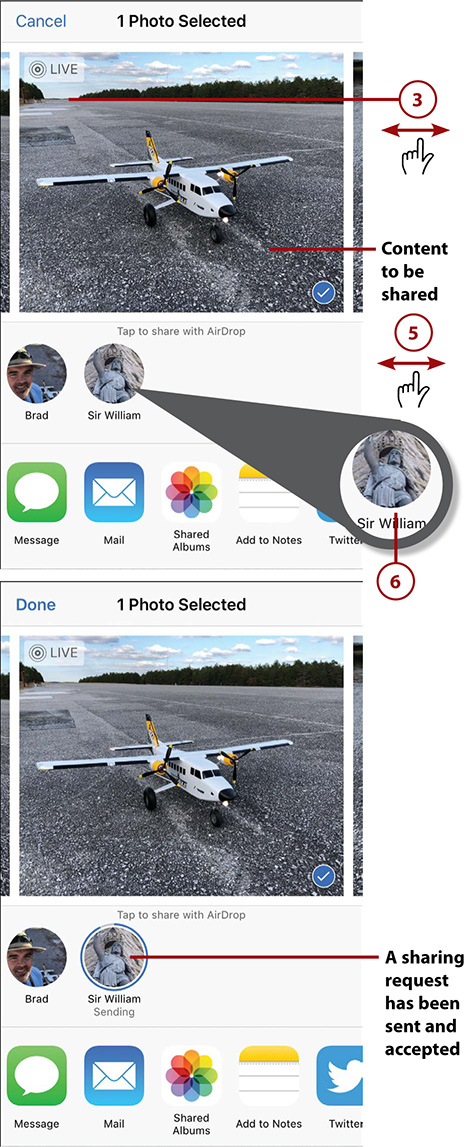
![]() If the app supports it, browse and select more content to share by tapping items that aren’t selected; tap items currently selected if you don’t want to send them again.
If the app supports it, browse and select more content to share by tapping items that aren’t selected; tap items currently selected if you don’t want to send them again.
![]() Tap the people with whom you want to share the content.
Tap the people with whom you want to share the content.
![]() When you’re done sharing, tap Done.
When you’re done sharing, tap Done.

Using AirDrop to Work with Content Shared with You
When someone wants to share content with you, you receive an AirDrop sharing request. (If you use AirDrop to share content among your own devices such as sending a photo from your iPhone to a Mac, it might be accepted automatically.) Respond to sharing requests by doing the following:
![]() Make sure you know the person attempting to share with you.
Make sure you know the person attempting to share with you.
![]() Make sure the content being shared with you is something you want. In this case, a photo is being shared.
Make sure the content being shared with you is something you want. In this case, a photo is being shared.
![]() To accept the content on your iPhone, tap Accept. To reject it, tap Decline.
To accept the content on your iPhone, tap Accept. To reject it, tap Decline.

![]() Use the associated app to work with the accepted content. For example, the Photos app provides tools to edit and share photos that are shared with you. In some cases, such as saving a contact shared with you, you need to tap Save to save the content on your iPhone or Cancel to not save it. (Other apps provide different controls depending on the type of content and the app it opens in.)
Use the associated app to work with the accepted content. For example, the Photos app provides tools to edit and share photos that are shared with you. In some cases, such as saving a contact shared with you, you need to tap Save to save the content on your iPhone or Cancel to not save it. (Other apps provide different controls depending on the type of content and the app it opens in.)

Working with the Wallet App and Apple Pay
The Wallet app manages all sorts of information that you need to access, from airline tickets to shopping and credit cards to movie tickets and rewards cards. Instead of using paper or plastic to conduct transactions, you can simply have your iPhone’s screen scanned.
You can also use the Wallet app to access your Apple Pay information to make payments when you are in a physical location, such as a store or hotel (Apple Pay is covered in detail in “Working with Apple Pay” later in this chapter). You can also use Apple Pay when you make purchases online using some apps on your iPhone.
Working with the Wallet App
You can store a wide variety of information in your wallet so that it is easily accessible. Examples include boarding passes, membership cards (to a gym for example), store cards (such as Starbucks if you are an addict like I am), and loyalty or discount cards (like those loyalty cards that grocery stores or gas stations offer). The Wallet app eliminates the need to carry physical cards or paper for each of these; instead, your information is available to you digitally, and you can enter it as needed by scanning the iPhone’s screen.

To open your wallet, tap the Wallet icon on a Home screen or first open the Control Center and then tap the Wallet icon. The Wallet app opens. At the top, you see the Apple Pay section that shows the cards you’ve enabled for Apple Pay. In the Passes section, you see other cards, such as boarding passes and loyalty cards.
As you add cards and boarding passes to your Wallet, they “stack up” at the bottom of the screen. Tap the stack to see the list of items available in your Wallet. The cards expand so that you can see at least the top of each card; if you have a lot of cards installed, swipe up or down on the screen to view all of them.
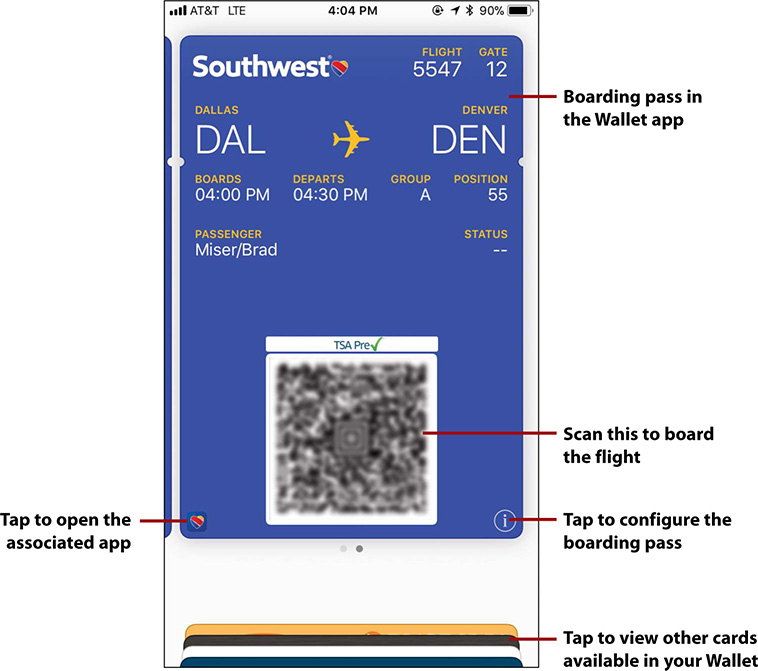
To use a card in your Wallet, tap it. It becomes the active card and you can access its information. For example, you can quickly access a boarding pass by opening the Wallet app and tapping it. To board the plane, you scan the code on the boarding pass. Even better, boarding passes start appearing on the Lock screen a few hours before the take-off time. Press (3D Touch) or swipe to the right (non-3D Touch) on the boarding pass on the Lock screen and you jump directly to the boarding pass in the Wallet app (you don’t even need to unlock your phone).
Some passes enable you to share them or information about them by tapping the Share icon and using the standard sharing tools that appear.
Others are connected to an app; you can tap the icon on the pass or card to move into the associated app.

When you tap a card’s Options icon (…), you can use the controls on a card’s Configure screen to adjust certain aspects of how the card works. If you set the Suggest on Lock Screen switch to on (green), for a card that works based on a location, such as your favorite stores, the card automatically appears on your Lock screen at the appropriate times. And, some cards can be automatically refilled from your bank account or credit/debit card so that they always have a positive balance.
To delete a card from your Wallet (such as a boarding pass when the flight is finished), tap Info (i), tap Delete or Remove Pass, and then confirm that you want to delete or remove it. The pass or card is removed from your Wallet.
When you’re done configuring a card, tap Done. The Configure screen closes and you return to the card you were configuring.
There are a couple of ways to add cards to your Wallet. The most frequent way to add a card is by using the Add to Wallet command in the app associated with the card. In some cases, you might be able to scan the code on a card to add it.
Adding Passes or Cards to Your Wallet Using an App
If you are a frequent patron of a particular business (perhaps you are a fan of Starbucks coffee like I am) that has an iPhone app, check to see if it also supports the Wallet app. For example, when you use the Starbucks app configured with your account, you can add a Starbucks card to your Wallet as follows:
![]() Open the app for which you want to add a pass or card to your Wallet.
Open the app for which you want to add a pass or card to your Wallet.

![]() Tap Pay. (These steps are specific to the Starbucks app, but you can add other cards to your Wallet in similar ways. Look for the command that enables you to configure how you pay for purchases associated with that card.)
Tap Pay. (These steps are specific to the Starbucks app, but you can add other cards to your Wallet in similar ways. Look for the command that enables you to configure how you pay for purchases associated with that card.)

![]() Tap the app’s command to manage its information; this command can be labeled with different names in different apps (it is the Details command in the Starbucks app), or it might be accessed with an icon or menu.
Tap the app’s command to manage its information; this command can be labeled with different names in different apps (it is the Details command in the Starbucks app), or it might be accessed with an icon or menu.

![]() Tap Add to Apple Wallet.
Tap Add to Apple Wallet.

![]() Tap Add. The card or pass is added to your Wallet and is ready to use. (You might be prompted to do some additional configuration of the card, such as to indicate favorite locations.)
Tap Add. The card or pass is added to your Wallet and is ready to use. (You might be prompted to do some additional configuration of the card, such as to indicate favorite locations.)
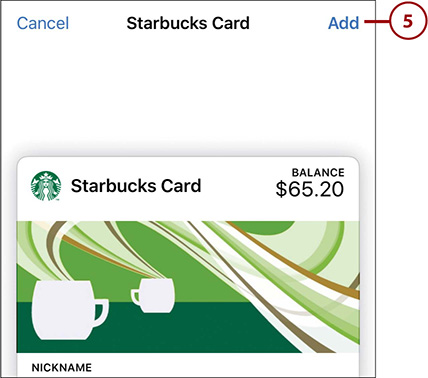
Finding Apps that Support the Wallet
You can search for apps that support the Wallet by opening your Wallet, tapping Edit Passes at the bottom of the Passes section, and tapping Find Apps for Wallet. This takes you into the App Store app and you see apps that support the Wallet. You can then download and install apps you want to use as described in Chapter 4.
Adding Passes or Cards to Your Wallet by Scanning Their Codes
In some cases, you can add a card or pass to the Wallet by scanning its code. To do so, follow these steps:
![]() Open the Wallet app and swipe up until you reach the bottom of the screen.
Open the Wallet app and swipe up until you reach the bottom of the screen.
![]() Tap Edit Passes.
Tap Edit Passes.

![]() Tap Scan Code.
Tap Scan Code.
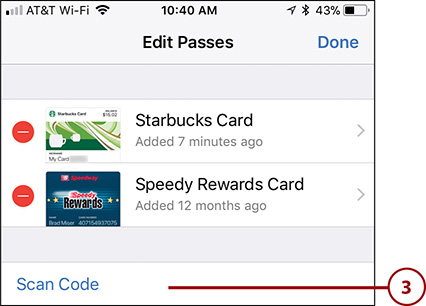
![]() Use the iPhone’s camera to scan the bar code on the card by positioning the phone so that the white box encloses the bar code on the card (not shown on a figure). If the bar code is recognized and is available for the Wallet, the pass or card is added to the Wallet and is ready for use. If the bar code isn’t recognized or doesn’t support the Wallet, you see an error and you need to find an associated app for the card to use it with the Wallet.
Use the iPhone’s camera to scan the bar code on the card by positioning the phone so that the white box encloses the bar code on the card (not shown on a figure). If the bar code is recognized and is available for the Wallet, the pass or card is added to the Wallet and is ready for use. If the bar code isn’t recognized or doesn’t support the Wallet, you see an error and you need to find an associated app for the card to use it with the Wallet.
Working with Apple Pay

With Apple Pay, you can store your cards in the Wallet app, and they are instantly and automatically available to make purchases. Apple Pay enables you to pay for things more easily and securely than with physical credit or debit cards. (Note that Apple Pay requires an iPhone 6 or later.)
When you use Apple Pay in a physical store, the steps to use Apple Pay are slightly different between X and non-X models.
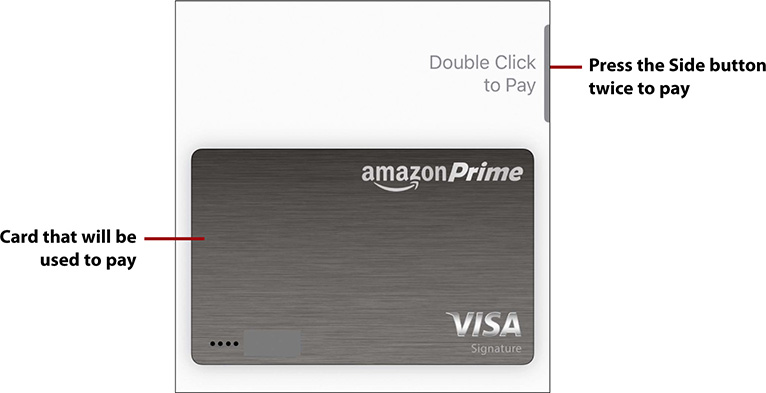
Apple Pay on an X model is a great way to pay for transactions quickly and easily. You can just hold your iPhone near the scanner, activate Apple Pay, press the Side button twice, hold the phone near the register, and look at your phone.
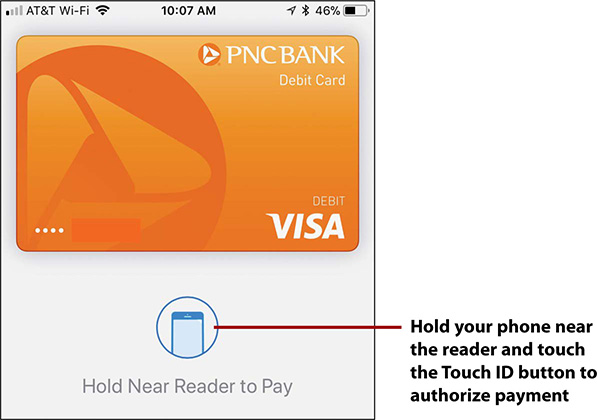
If you are using Apple Pay on a non-X model, you can simply hold your iPhone up to a contactless reader connected to the cash register and tap your finger on the Touch ID button. The iPhone communicates the information required to complete the purchase.
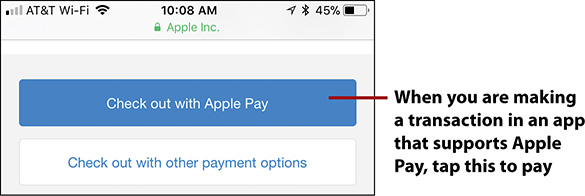
Apple Pay also simplifies purchases made in online stores. When you use an app or a website that supports Apple Pay, you can tap Check Out with Apple Pay, Buy with Apple Pay, or a similar onscreen button to complete the purchase.
Apple Pay is actually more secure than using a credit or debit card because your card information is not passed to the device; instead, a unique code is passed that ties back to your card, but that can’t be used again. And, you never present your card so the number is not visible to anyone, either visually or digitally.
Apple Pay Support
In addition to requiring an iPhone 6 or later model, a credit or debit card must support Apple Pay for it to work with that card. The easiest way to figure out if your cards support it is to try to add a card to Apple Pay. If you can do so, the card is supported and you can use it. If not, you can check with the credit or debit card company to see when support for Apple Pay will be added so you can use it.
Adding Credit or Debit Cards to Apple Pay
To start using Apple Pay, add a credit or debit card to it:
![]() Open your Wallet by tapping its icon on the Home screen.
Open your Wallet by tapping its icon on the Home screen.

![]() Tap Add (+) in the Apple Pay section at the top of the screen.
Tap Add (+) in the Apple Pay section at the top of the screen.
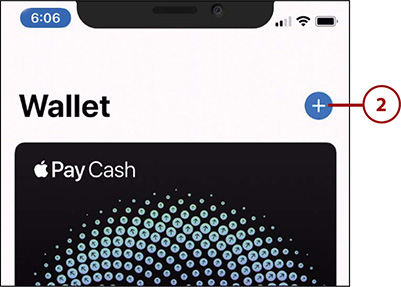
![]() Tap Continue.
Tap Continue.
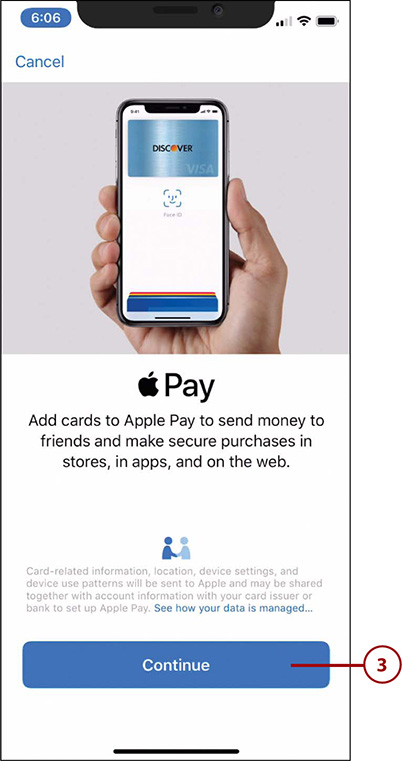
![]() Position the iPhone so that the card is inside the white box. The app captures information from the card, which is highlighted in white on the screen. When it has captured all the information it can, you move to the Card Details screen.
Position the iPhone so that the card is inside the white box. The app captures information from the card, which is highlighted in white on the screen. When it has captured all the information it can, you move to the Card Details screen.
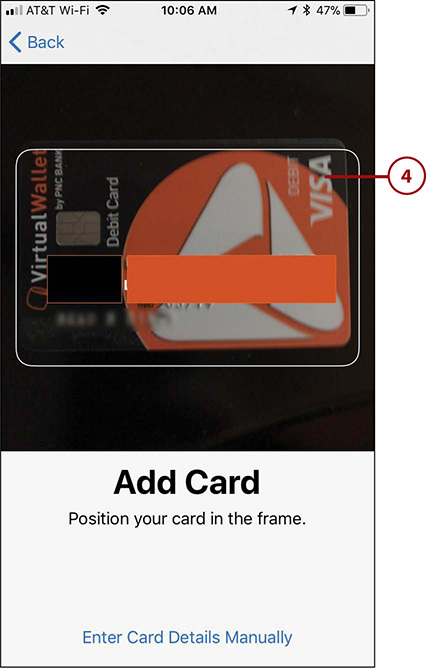
Prefer to Type?
If you don’t want to use the camera option, or if that option doesn’t capture the information correctly, you can also type your card’s information directly into the fields. To do this, perform step 3, and then tap Enter Card Details Manually, which is at the bottom of the Scan screen. You can use the resulting Card Details screens to manually enter the card’s information.
![]() Use the keyboard or keypad to enter any information that wasn’t captured or to correct any information that wasn’t captured correctly.
Use the keyboard or keypad to enter any information that wasn’t captured or to correct any information that wasn’t captured correctly.
![]() Tap Next.
Tap Next.

![]() Use the keyboard or keypad to enter any information that wasn’t captured or to correct any information that wasn’t captured correctly.
Use the keyboard or keypad to enter any information that wasn’t captured or to correct any information that wasn’t captured correctly.
![]() Tap Next.
Tap Next.

![]() Tap Agree. The information for the card is verified. If it can’t be verified, you see an error message. For example, if the card doesn’t support Apple Pay, you see a message saying so. If this happens, tap OK to close the message and then wait for your card to support Apple Pay or enter a different card’s information. When the card’s verification is complete, you see it in your Wallet. Once the card is activated, you are ready to use it with Apple Pay.
Tap Agree. The information for the card is verified. If it can’t be verified, you see an error message. For example, if the card doesn’t support Apple Pay, you see a message saying so. If this happens, tap OK to close the message and then wait for your card to support Apple Pay or enter a different card’s information. When the card’s verification is complete, you see it in your Wallet. Once the card is activated, you are ready to use it with Apple Pay.


More Verification Required
In some cases, there might be an additional verification step after you tap Agree in step 9. When this is the case, the Complete Verification screen appears. Tap how you want to receive the verification code, such as via Email or Text Message, and then tap Next. The card configuration completes. You should receive a verification code. When you have the code, open the Settings app and tap Wallet & Apple Pay. Tap the card you need to verify, and then tap Enter Code. Enter the verification code you received; when you enter the correct code, the card is verified and becomes available for Apple Pay.
Managing Apple Pay
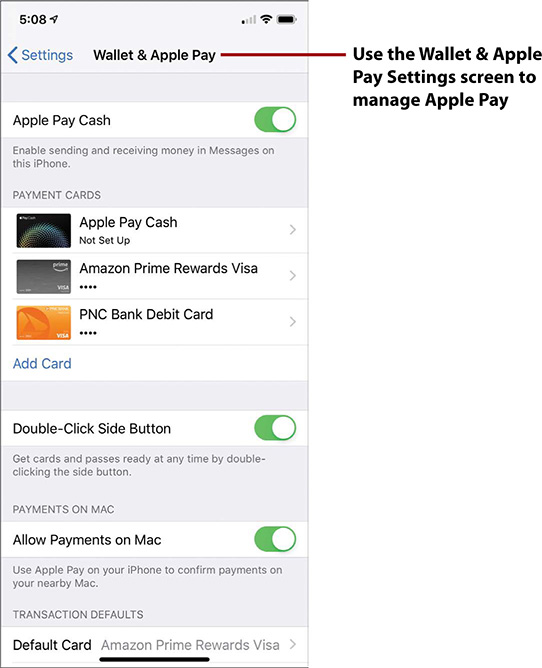
To manage Apple Pay, open the Settings app and tap Wallet & Apple Pay. On the resulting screen, you can do the following:
Enable and configure Apple Pay Cash (see Go Further “Paying People with Apple Pay Cash”).
Tap a card to configure it, such as to determine if notifications related to it are sent. You also see a list of recent transactions for the card.
Add a new credit or debit card (tap Add Card and follow the prompts).
Use the Double-Click Side Button switch (X models) or Double-Click Home Button switch (non-X models) to determine whether you can access the cards in your Wallet by pressing the Side button or the Touch ID/Home button twice. This makes using your Wallet even easier because you press the associated button twice and your cards appear; tap a card to use it and then use Face ID or Touch ID to complete the process.
Set the Allow Payments on Mac switch to on (green) if you use a Mac computer and want to be able to use Apple Pay for online transactions.
Set your default Apple Pay card. The default card is used automatically; you have to manually select other cards in the Wallet app to use one of them instead.
Update your shipping address, email addresses, and phone numbers.

You should also make sure Apple Pay is set to use Face ID (X models) or Touch ID (non-X models) because this makes it much easier and faster. Open the Settings app, tap Face ID & Passcode (X models) or Touch ID & Passcode (non-X models), and then enter your passcode. Ensure that the Apple Pay switch is on (green). This enables you to complete Apple Pay transactions by looking at your phone (X models) or touching the Touch ID/Home button (non-X models). (See Chapter 4 for the steps to help you configure Touch ID.)
Working Seamlessly Across Your Devices
Your iPhone can work seamlessly with other iOS devices running iOS 8 and later (such as iPads) and Macs running OS X Yosemite and later. This enables you to change devices and keep working on the same tasks. For example, you can start an email on your iPhone and then continue it on your Mac without missing a beat.
You can also take phone calls on iPads or Macs.
Working with Handoff
Handoff enables you to work seamlessly between iOS devices, as well as Macs running OS X Yosemite or later. Each device needs to be signed into the same iCloud account and have Handoff enabled. If you do not have multiple iOS devices running iOS 8 or later, or a Mac running OS X Yosemite or later, then there is no need to turn on this feature.
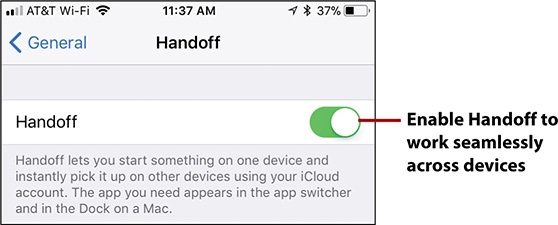
Ensure that Handoff is enabled on all the devices with which you want to use it. On iOS devices, enable Handoff by opening the Settings app, tapping General, and then tapping Handoff. Set the Handoff switch to on (green).
To enable handoff on a Mac running OS X Yosemite or later, open the System Preferences app, and then open the General pane. Ensure that the Allow Handoff between this Mac and your iCloud devices check box is checked.

If you want to be able to take phone calls on other devices, open the Phone settings and tap Calls on Other Devices. Set the Allow Calls on Other Devices switch to on (green). Set the switch to on (green) for each device on which you want to be able to take calls.
Using Handoff
When Handoff is enabled on your devices, you can work on the same items on any device, as the following example of working with email shows:
![]() Start an email on your iPhone (this only works for iCloud email).
Start an email on your iPhone (this only works for iCloud email).
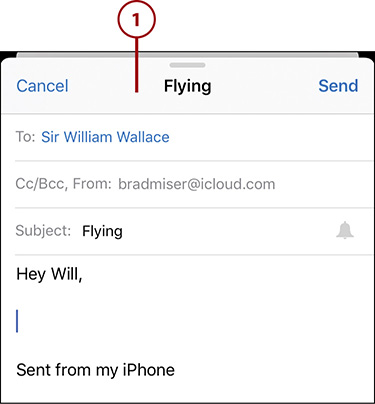
![]() To work on the email on another iOS device, swipe up on the Mail icon on its Lock screen and unlock the device or to work on a Mac, click the Handoff icon on the left end of the Dock.
To work on the email on another iOS device, swipe up on the Mail icon on its Lock screen and unlock the device or to work on a Mac, click the Handoff icon on the left end of the Dock.

![]() Work on the email on the iOS device or Mac.
Work on the email on the iOS device or Mac.

Handoff Goes Both Ways
This works in the other direction, too. For example, if you open a web page on your Mac, you see the Safari icon on the iPhone’s Lock screen. Swipe up on it and unlock your iPhone, and the web page on your Mac opens on your iPhone.
Most Apple apps support Handoff, and Apple has made it available to other software developers so they can add support to their apps, too.
Taking Phone Calls on Macs or iPads

When your iPhone is on the same Wi-Fi network as an iPad running iOS 8 or later, or a Mac running OS X Yosemite or later, you can take phone calls on those devices. When a call comes in to your iPhone, you see the call screen on the other devices and can take the call on one of those devices (see Chapter 7, “Communicating with the Phone and FaceTime Apps”).
